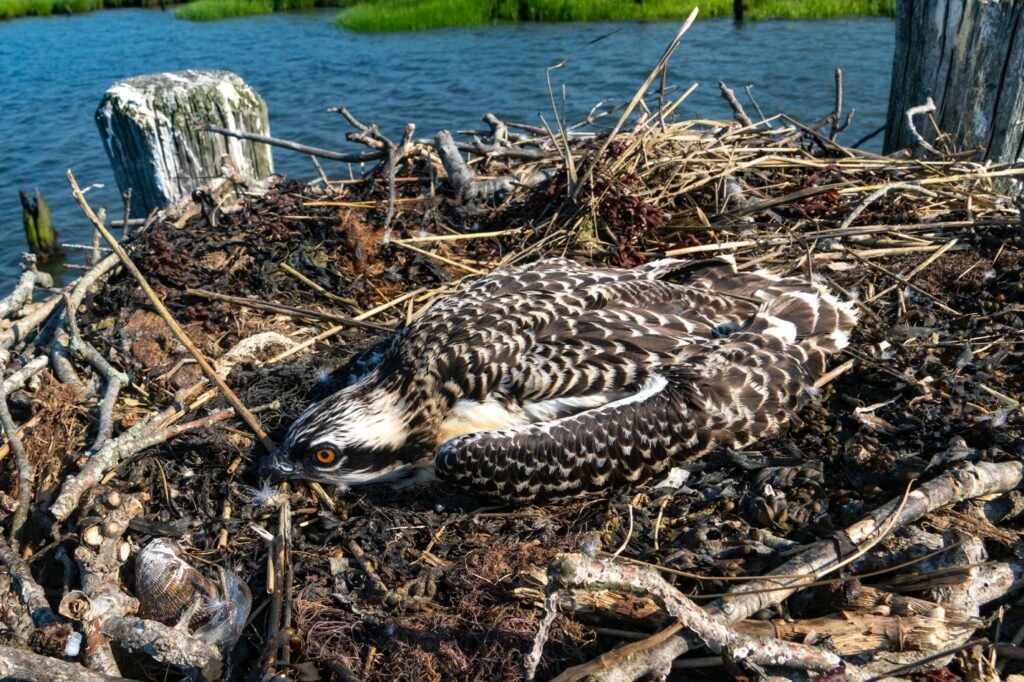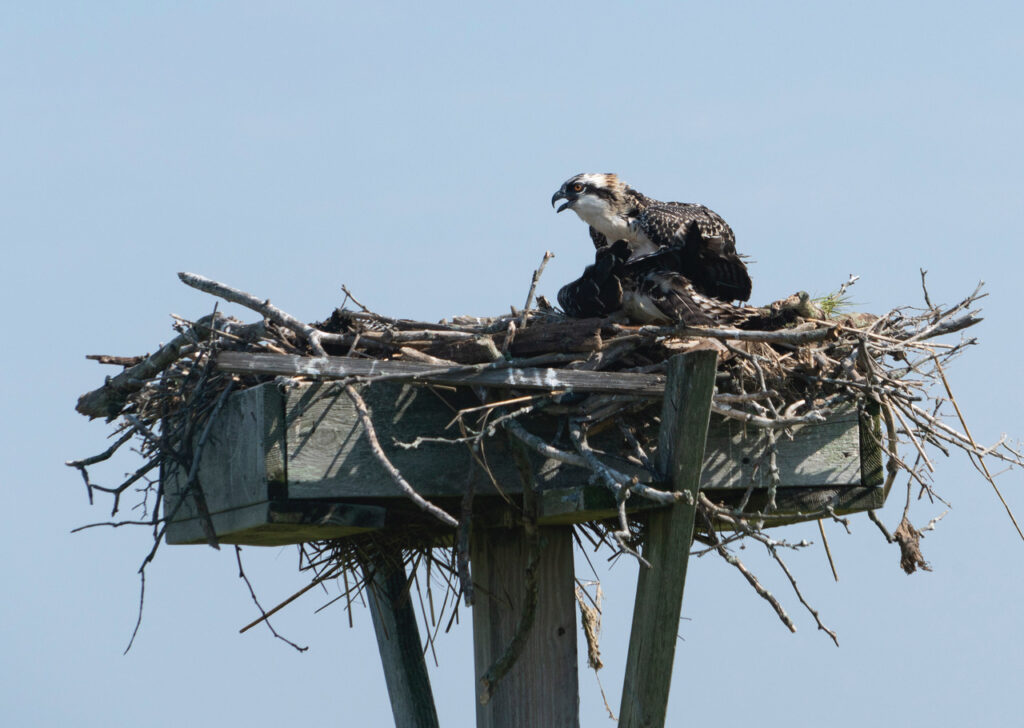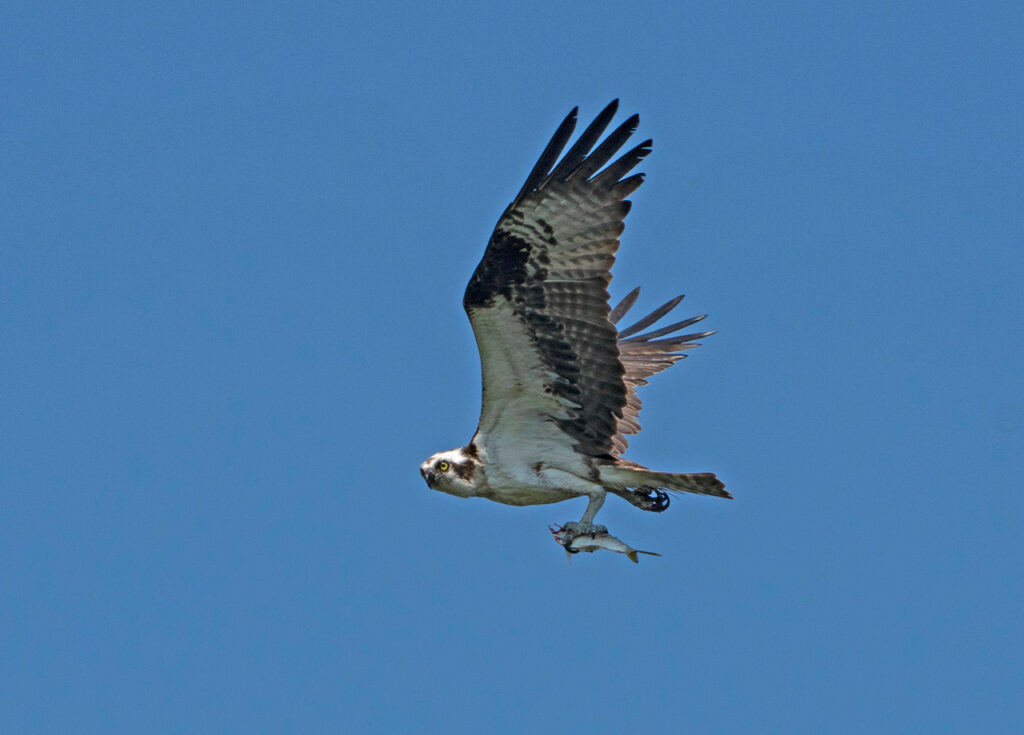STEVE JASIECKI/Bill Stuempfig checks an osprey nest.
By STEVE JASIECKI
As the summer ends and fall begins, ospreys prepare to leave their summer breeding grounds and head for their winter homes.
Ospreys arrive each year in the middle of March to prepare their nest and rear their young through the summer. Spring and summer yield the right climate with abundant fish, which is essential for a successful breeding season to sustain their populations.
One of the activities I look forward to in the summer is to assist my friend Bill Stuempfig count and band young osprey chicks. Bill is a licensed volunteer with the Conserve Wildlife Foundation who is permitted to approach the Federal protected species.
 A healthy juvenile osprey lays perfectly still and blends in with its nest.
A healthy juvenile osprey lays perfectly still and blends in with its nest.
It's not a glamorous job by any means, carrying a ladder through the muddy wetlands and sometimes being attacked by blood thirsty insects and baking in the hot summer sun. But to me, it's enjoyable getting up-close to the environment I love. It's rewarding taking part in monitoring a species that is so important to the survival of the wetlands.
The osprey is an indicator species, meaning that their presence and population is a good indicator of the health of the wetlands. More than 50 years ago due to poor environmental practices, New Jersey ospreys were all but gone with only a few nesting pairs remaining. Corrections were made and with conservation measures, their population has improved greatly and are no longer threatened. Monitoring and recording these birds has taught wildlife researchers much about their life cycle and breeding habits, while banding and counting the chicks tells us how well the population is growing.
This summer proved to be a very weak year for South Jersey ospreys, particularly in Stuempfig's monitored area, from Atlantic City to Sea Isle City. The coastal area covers the back bays, barrier islands and rivers east of the Garden State Parkway.
 According to Stuempfig, 70% of the nests in his area have failed to produce osprey fledglings. Other areas weren't quite so high, but the reproduction count was still low.
According to Stuempfig, 70% of the nests in his area have failed to produce osprey fledglings. Other areas weren't quite so high, but the reproduction count was still low.
Having a low fledging count is very concerning, and finding the cause is important.
In the July Conserve Wildlife Newsletter, Habitat Program Manager Ben Wurst explained this phenomenon.
The empty or failed nests seems to be the result of the weeklong nor'easter which hit the area during the second week of May. The strong northeast winds made foraging very difficult for coastal nesting ospreys and caused females to abandon incubation to attempt to forage for themselves (since their mates were unable to catch prey) and avoid starvation. This left eggs vulnerable to predation from avian predators like gulls and crows.
The timing and duration of the weather pattern came at a critical time for the ospreys. Ospreys are excellent hunters but the inability to bring back food put excessive stress on the birds. Ospreys nesting further inland had a higher success rate. They benefited by flying up the rivers where they had more opportunities to catch fish.
 Although the osprey hatchling population fell short of previous years and is a bit of a setback, it is good to know that the low birth rate was due to an unusual act of nature.
Although the osprey hatchling population fell short of previous years and is a bit of a setback, it is good to know that the low birth rate was due to an unusual act of nature.
It is interesting to note how a healthy environment and weather conditions play a vital role in the success of a species. We look forward to the ospreys returning next year and having a successful breeding season.